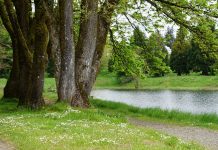Early Napavine settlers, John and Mary Jane MacDonald fell in love—literally! Their unforgettable pioneer love story took place during the height of the California Gold Rush and the Oregon Territory land rush. Both historical events played a part in the meeting and marriage of the MacDonalds.
In January of 1851, Mary Jane Cutting and her family set sail from London with the glowing dream of homesteading their own land in the beautiful, untamed wilderness of Lewis County. Perhaps lured by letters from her Uncle George B. Roberts, a Hudson’s Bay Company clerk who had settled on the Newaukum Prairie, Mary Jane’s parents packed up their three children and belongings and booked passage on the Emma B. Hunt which would take them on the first leg of their ocean voyage—as far as San Francisco. Their 205-day trip was full of excitement and adventure.

On the way, their ship was attacked by pirates. Fortunately, the captain was prepared and gave the pirates a hearty reception causing the rogues to flee. The ship sustained some minor damage to the bulwarks and rigging, but once repaired, the vessel continued around the Horn and arrived in San Francisco Bay by mid-summer.
After months at sea, the Cutting children must have been in awe at their first glimpse of the famous boomtown. In 1851, San Francisco was bustling with commerce, construction, and the California gold fever. Standing on the deck of the Emma B. Hunt, Mary Jane, her younger sister Katie, and little brother J.W. probably marveled at the number of tall-masted ships and new-fangled steamboats that packed the harbor. From their vantage point next to the busy docks, they must have noticed the enthusiastic miners heading to the gold fields, burly sailors unloading barrels and crates of cargo, and well-dressed merchants conducting business. Perhaps the young men also noticed Mary Jane—a young woman was a rare commodity and welcome sight in those early boomtown days.
Meanwhile, her father John Henry Cutting had rented temporary accommodations for his family in the city as they planned to stay for a while before continuing north. At last, the family made ready to come ashore. Mary Jane must have been eager to finally leave the confines of the ship and set foot on land again. Holding her long skirts in one hand, she carefully stepped onto the gangplank.

Without warning, the plank slipped from the dock, tossing a surprised Mary Jane into the chilly waters below. Weighted down by heavy skirts, she desperately struggled to keep her head above water. An alert young customs house officer, John Malcom MacDonald Jr, saw her tumble into the bay and immediately jumped in after her. He caught and held onto her until help came.
His heroic plunge eventually led to a heartfelt proposal. Following the rescue, the grateful Cutting family extended John an invitation to visit which he gladly accepted. Over the next several months, the young Scotsman won the heart of the young English woman he had saved. By the time the Cutting family set sail for the Oregon Territory in 1852, John and Mary Jane were engaged with plans to marry as soon as John could join them in Lewis County.
With that promise, Mary Jane and her family climbed aboard the Astoria bound for Oregon Territory at last. They traveled the last leg of their journey up the Cowlitz River by canoe, arriving at Cowlitz Landing to a warm welcome by Mary Jane’s Uncle George Roberts. On the way to the Roberts’ homestead on the Newaukum Prairie, the Cuttings enjoyed the gracious hospitality of John and Matilda Jackson, one of Lewis County’s earliest homesteaders who would prove to be true friends to both the Cuttings and MacDonalds in the years ahead.

After spending the winter with their relatives, Mr. Cutting took up a 320-acre donation land claim on the prairie south of present-day Napavine where he built a log home and moved his family in 1853. Mary Jane’s fiancé John arrived later that year, and the two were married at the Cutting family home on November 29, 1853. John R. Jackson, Justice of the Peace, performed the ceremony, and his wife Matilda hosted a wedding breakfast for the newlyweds at the Jackson’s log cabin home, also known as “The Old Jackson Courthouse.”
The young married couple settled near Mary Jane’s family, taking up a 320-acre donation land claim just southeast of her parents on land that sits between present-day Jordan/Koontz Roads and Avery Roads south of Napavine. The military road built in 1861 that connected Monticello (Longview) to Olympia ran directly through their land.

Over the years, many a weary traveler taking the stagecoach north to Washington’s Territorial capital stopped at “MacDonald’s Station” where they enjoyed Mary Jane’s hearty farm-cooked breakfasts. In addition to running the stage station, John continued to develop their homestead, which they called “Ferndale Farm,” and also served some years as the local postmaster.
The couple had several children and lived out the rest of their days on their land which became known as “MacDonald’s Prairie.” John passed away in 1893 and Mary Jane in 1909. They are both buried at St. Francis Cemetery in Cowlitz Prairie.

John and Mary Jane MacDonald’s sweet pioneer love story spanned four decades. During their married lives, they witnessed Washington grow from a territory to a state, saw the advent of stagecoaches, trains, and the telegraph, and experienced the rigors of isolated pioneer life slowly give way to a more “modern” lifestyle as the nearby town of Napavine grew and prospered. Little did John know his heroic plunge that summer day would change the course of his life, leading him away from the California gold fields into the untouched prairie and forests that would be tamed by his own hand—indelibly stamping his name on the history of Napavine and on the heart of the young woman he saved.
Historical note: In 1852, when Mary Jane Cutting and her family first settled in Lewis County, the region was still considered part of Oregon Territory. Washington became a separate territory in 1853, the same year the MacDonalds were married.













































